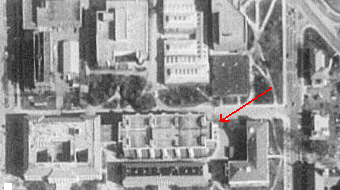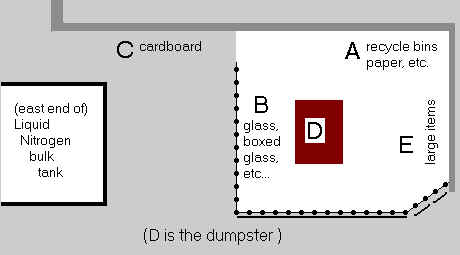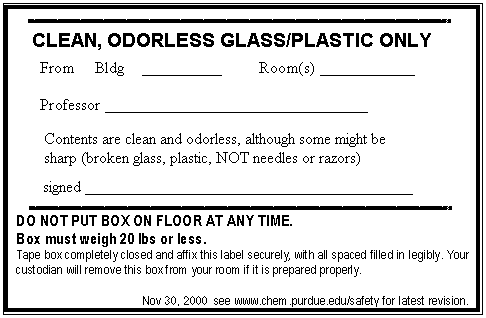Trash
Whether you will take anything to the dumpster area yourself, or will keep them in the room until the custodial staff removes them (those are the choices), follow these guidelines:
Regular Trash:
The regular trash is removed from your trash baskets by the evening shift ( approx 3 - 11 pm) Building Services staff (Custodians), and taken to the compacter near the east end of BRWN. Your relationship with your custodian is important.
Items which may be placed in the regular trash baskets are items which:
- are NOT contaminated with chemicals, biologicals, and/or sources of ionizing radiation, and
- are NOT glass, and
- are NOT sharp (capable of cutting or puncturing anyone who handles the trash, and
- are NOT appliances
- fit into the trash receptacles
This "regular trash" group includes plastic or metal chemical containers if they are empty, clean, odorless, and have a SFD sticker affixed. Also see Non-Haz chemicals below.
Sharp Things:
Items which could cut or puncture the refuse handlers, and which are not chem, bio, or rad waste, do eventually go to the regular trash dumpster, but not via your regular trash basket:
Broken glass, Pasteur pipettes, TLC plates (clean and odorless)... should be collected in a sturdy cardboard box or plastic bucket. Cardboard box should weigh no more than 20 lbs and must be labeled "clean glass for regular trash" or have SFD stickers.
THESE CONTAINERS ARE TO BE KEPT INSIDE ROOMS (and out of the "walking and working" floor space), UNTIL THEY ARE TAKEN TO THE DUMPSTER AREA. If you want your custodian to take out boxed glass, follow the instructions given in C. below under Glass bottles and jars, and on the box label shown there. The razor/needle container can also be taken out by the custodian but you will have to call his/her attention to it. You may also take these items to the proper location by the dumpster yourself. But not right before it rains. The cardboard falls apart and the Grounds crews complain bitterly.
Needles, razor blades, scalpels, cannulae... -- cleaned chemical and non-regulated biomaterials needles...(clean and odorless) are to be collected in a rigid screw-cap container (metal or plastic, e.g. an old ether can or rigid laundry soap bottle with a new label), and the container must be labeled "CLEAN RAZOR BLADES & NEEDLES FOR REGULAR TRASH." Do not use the red "sharps" biohazard containers unless you have money to throw away.
Glass bottles and jars:
Individual (intact) glass bottles/jars
- Must be clean, uncapped, and odorless.
- Must be identified as safe for disposal by
- use of yellow SFD sticker on each container, or
- defacing the original label, or
- boxing in cardboard box and labeling the box with some "clean glass trash" label such as shown in C. below
- Must be kept in the lab or office (not in the walking/working floor space and NOT IN THE HALLS) until the custodian takes it/them out, or put in the the proper location of the refuse/recycling area east of BRWN.
If your Custodian or your local Building Services supervisor asks that the yellow label be used on the glass bottles or on boxes of glass, please cooperate with this.
Very small glass containers
Very small glass containers can go into the broken glass collection without SFD stickers; the preferred size limit might vary with your custodian. If there are problems with this please contact me. Do not put containers (or anything else) in the hallway.
IF YOU USE ACETONE or any other agent FOR CLEANING, RINSE WITH WATER AFTERWARD.
Boxed clean glass, broken or not broken
Follow directions on the label above and your custodian will take it out. Select the box label for a standalone image version which you should be able to print from your browser. If that doesn't work, shift-click on the bmp here and save it to your hard drive; print it from a paint program such as Photoshop.
Fly-away materials (powders, vermiculite, etc...)
Powdery or other fly-away materials such as talc, silica, and vermiculite, should not be place directly in your regular trash basket even if they are not hazardous materials and not contaminated with hazardous materials. The way they must be handled differs from material to material.
- Unused but unwanted silica should be put with waste silica if you have a waste silia container. If you don't have a waste silica container and it's a small quantity (a lb or 2), ask a neighboring group if you can put it in theirs. Otherwise, write it up on a chemical pickup request.
- Other powders should be written up on a chemical pickup request as well, unless they REM non-haz guidelines say you can put them down the sink. If they are non-haz but can't go down the sink, they go to the trash dumpster, but
-
- glass containers are not to be put in the regular trash baskets, nor into the dumpster by anyone except the refuse/recycling personnel, and
- any non-haz solid for dumpster disposal must have a label say its chemical name and the words NONHAZ -- SAFE FOR REGULAR TRASH
- Vermiculite (the crumbly, brown/tan solid used in packaging many things for shipment, including between the bottle and the can for many chemicals shipped from Aldrich, Fisher, Baker....). It is not by itself classified as hazardous, but it drives some of the custodians nuts if you put it in your trash basket, and they don't see it, and it flies everywhere when they dump your trash into their cart! (So why don't they just remove the liner like everybody does at home? The expense of trash basket liners is not the issue, although some custodians have said that they are reprimanded for "using too many," or that they are "only allowed a certain number per week." I hear that this is BS, and that the real reason is that it takes longer to change the liner than to just dump the trash. I'm not sure what to believe.)
- If you have the occassional oil spill you'd do well to save verm in a labeled container, and use it to soak up little oil spills. Pump oil, silicon oil, and mineral oil, all of these can be adsorbed/absorbed with verm, bagged, labeled ("VERMICULITE AND MINERAL OIL -- NONHAZ -- SAFE FOR REGULAR TRASH") and placed in the regular trash basket. Non-haz spills cleanups larger than 3 L or so are best picked up by REM as if they were hazardous.
- If you have no need for vermiculite, you might out of consideration for your custodian decide to bag vermiculite (and/or foam "packing peanuts" as well). This is not a rule (not yet anyway); simply a coutesy which would take very little time.
Appliances, instruments, equipment, furniture
- Anything with a PU Property Accounting ID number must be "Form Nined." Chem Stores (WTHR 225A) is where you start with the Form 9 process.
- Refrigerators, freezers, air conditioners -- the coolant must be removed by the Chem Shop before these can be discarded.
- Ask if the instrument shop (JAFCI) wants it (if it's an instrument or part of an instrument).
- Ask if the Chem Shop wants it. They sometimes will repair items and give them to some other needy research group, or might use them for parts (heating mantles, variacs, ovens, ... all manner of items).
- Furniture and other large items which do not belong to Purdue -- they can usually go out to the dumpster area but don't just take them out there without asking about it. Chem Shop can usually help you coordinate with the Custodian Supervisor if you are unfamiliar with the process.
Cardboard & other misc
Keep it in the lab and alert your cusotdian that it is to be taken out, or take it out yourself. See diagram of dumpster area for cardboard recycling area. DO NOT PUT IT IN THE HALLWAY, NOT EVEN FOR A LITTLE WHILE. This means everything. Pizza boxes too. Hallways are not to be used for trash transfer or any storage however temporary, even if your custodian tells you to. (They're not supposed to be telling you to put anything in the hallway, either.)
Non-Haz chemicals
There is detailed information in the REM Chem Waste Guidelines Table III about what is hazardous and what is not. Use that table to determine if your unwanted chemical is non-haz, then either:
- Sink-dispose ("sewer-dispose") it with running water, or
- Send insoluble non-haz solids to the regular trash with a label on the container stating the chemical name plus the words NONHAZ -- SAFE FOR REGULAR TRASH. No glass containers are to be placed in your trash basket, so unless it's in a plastic or metal container, it has to go out separately to the pavement next to the dumpster (see area "B") via your custodian or yourself.
A Note On Hallways
Hallways are to be kept clear of all items. Not only trash, but just plain all items. Hallways are not for trash transfer, excess furniture, file cabinets, incubators, ovens, refrigerators, etc. "Temporary" use, for a period of time less than 8 hours, is arguably acceptable (unless they cause something bad to happen). The departments/buildings in which the hallways are not kept clear are breaking the law and asking for big trouble.
Not allowed
- boxes, cans
- bottles, jars
- trashcans
- toolboxes
- tables, chairs
- carts, desks
- pipes, hoses
- cabinets
- Etc
PEOPLE are permitted. In fact, hallways are for people.
It is not permissible to store equipment, place trash or other discarded items, or set up study desks/table, etc.... in the building corridors without express written permission from the University Fire Safety Division. (Permission is unlikely.)
IF YOU TAKE YOUR OWN THINGS OUT -- put them in the proper areas.

In this 1993 satellite photo the red arrow points to the 6000 gallon nitrogen bulk tank which sits near the loading dock at the east end (Grant St. is east) of BRWN. The dumpster enclosure and recycling areas are immediately east of that tank.
Enlarged view below shows locations for various materials. The dumpster area is enclosed by brick, wood, and steel fence on its various sides.
- Location of recycle bins for office paper and newprint.
- Bottles, boxed glass items, non-haz solid chemicals in glass containers, and razor blade/needle containers, on the ground/pavement inside the enclosure between the dumpster and the fence. Do not block the walkway into the enclosure.
- Cardboard only. Boxes do not need to be broken down, but arrange them neatly
- Large items like tables, desks, plumbing... might be seen here. Coordinate large item disposal with

